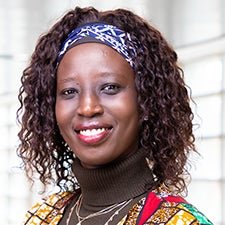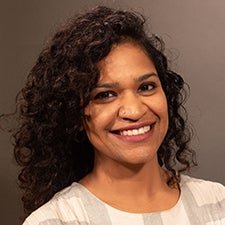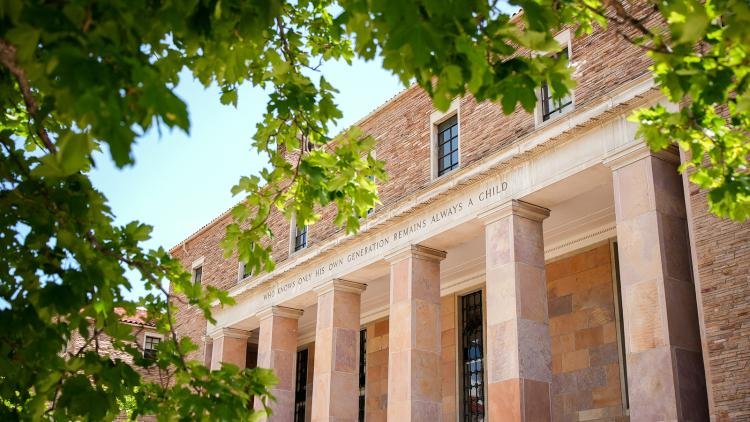by Joe Arney
Photo by Kimberly Coffin (CritMedia, StratComm’18)
When asked why they choose the University of Colorado Boulder, students and faculty alike tend to cite its location along with academic prestige, research successes and access to opportunities.
It was also a big move for Joe Izaguirre III. But it wasn’t the mountains he had in mind when he signed up as an assistant professor in communication at the University of Media, Communication and Information.
Izaguirre studies how political power affects Latino identities from the lens of public rhetoric and rhetorical histories. Much of the source material for his book includes texts produced by activists who lived in the Colorado area.
“I hadn’t thought of this, but I’ll be able to hand-deliver the book to families who attended instead of just dropping it in the mail,” he said. “It feels like an opportunity to have a more personal connection to the things I’ve been studying.”
Izaguirre is among the seven new tenure-track faculty joining CMCI this fall. The college also welcomes seven non-tenure-track faculty, including new appointments for professors who previously held different roles.
“I am so excited to welcome our new faculty to CMCI,” said Lori Bergen, founding dean of the college. “As the media, communications, design and information landscape continues to change dramatically, the new perspectives these professors bring will ensure our students receive a cutting-edge, immediately applicable education.”
“It was a great experience as an instructor to be able to work with students who were so interested in learning and participating.”
Dinfin K. Mulupi, Assistant Professor, Journalism
Design thinking
For the first time, this year’s incoming cohort includes faculty from the Environmental Design program, which formally integrated with CMCI over the summer. While there are no changes for current students, faculty in the program are excited about the chance to collaborate with colleagues eager to explore new applications for their work.
Martín Paddack, a teaching associate who joins CMCI and ENVD after seven years at Howard University, has a wealth of interests around architecture and sustainability, including participatory design – “understanding how we identify where there is a need and try to making connections with the community for design.”
 “I always try to instill in students that it’s not about coming up with an idea and saying, here’s the answer,” said Paddack, who is also the founder and principal of the Washington, DC-based DesignMAP firm. “It’s about communication – asking the right questions and really listening so you can identify where the needs are. If you’re prescriptive and don’t listen to your community, that’s where design starts to fail.”
“I always try to instill in students that it’s not about coming up with an idea and saying, here’s the answer,” said Paddack, who is also the founder and principal of the Washington, DC-based DesignMAP firm. “It’s about communication – asking the right questions and really listening so you can identify where the needs are. If you’re prescriptive and don’t listen to your community, that’s where design starts to fail.”
Paddack brings a variety of interests—architecture, sustainability, social responsibility, writing, painting, woodworking—to the classroom, as well as a global perspective: He was born in Puerto Rico and raised in Peru and Uruguay before moving to DC as a boy . He also taught in South America and completed a painting residency in Barcelona. He helped establish a fabrication lab at Howard to ensure students developed both hands-on architectural experience.
“That’s something I really like about environmental design at CU – the focus on how we can apply sustainable principles across four different areas, and an emphasis on doing hands-on so students learn the theory but also how to apply it,” he said.
‘Fantastic experience’ in connection with students
 Most new faculty who join CMCI say they feel an immediate rapport with professors in their departments, making the college feel at home well before they start. That was also true for Dinfin K. Mulupi, but she felt an equally strong connection to the journalism students she taught as part of the interview process.
Most new faculty who join CMCI say they feel an immediate rapport with professors in their departments, making the college feel at home well before they start. That was also true for Dinfin K. Mulupi, but she felt an equally strong connection to the journalism students she taught as part of the interview process.
“I was intrigued by their interest in learning the research behind journalism practice,” said Mulupi, a native of Kenya who came to CMCI via the doctoral program at the University of Maryland, College Park.
A discussion she had criticizing news coverage of immigration, Mulupi said, sparked so much insightful discussion that she felt bad moving on to the next topic.
“It was a great experience as an instructor to be able to work with students who were so interested in learning and participating,” she said. “When you’re a professor, you create knowledge with your students, and they were so attentive and involved that I know it will be a privilege to teach them.”
Mulupi’s research looks at sexism and sexual harassment in newsrooms and came out of work on her dissertation when the #MeToo movement took off. She was among the first researchers to explore the topic in Kenyan newsrooms; her work has since expanded to more than 20 countries.
It’s an important issue at a time when the news industry is contracting because “when you have a newsroom culture of sexism, harassment, racism and bigotry, you lose talented journalists who don’t feel safe and included,” she said. “I also focus on solutions, particularly exploring how we can build safer, more inclusive newsrooms that produce news content that serves the diverse needs and interests of a wider audience.”
 Pooja Iyer, who joined CMCI from the University of Texas Austin, where she completed her doctoral work this spring. She also does timely work examining the ethics of how advertising companies collect and use data in connection with consumers.
Pooja Iyer, who joined CMCI from the University of Texas Austin, where she completed her doctoral work this spring. She also does timely work examining the ethics of how advertising companies collect and use data in connection with consumers.
“In my industry days, I realized my own cognitive dissonance — asking how granular we could get on a target audience while I had ad blockers on my computer,” said Iyer, an assistant professor in the Department of Advertising, Public Relations and Media Design. “I believe the advertising world can play a more ethical role in how and why they use data and how they protect customers – because there is not enough literacy around this.”
It’s something her students will have to consider when they graduate, she said.
“Whether you’re working in creative, account management, media planning, it doesn’t matter — you want to work with data,” Iyer said. “So how can we best empower you to be ethical about the use of this data? As educators, that really needs to be at the center of our students.”
